Why the Moabite Stone Was Blown to Pieces
Ninth-century B.C. inscription adds new dimension to Biblical account of Mesha’s rebellion
050
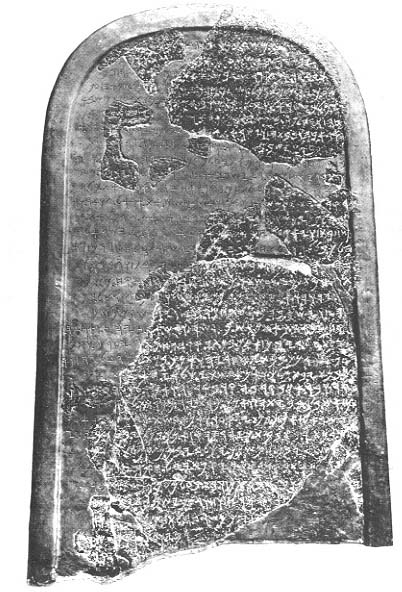
F. A. Klein was an Anglican minister, born in Alsace, who came to the Holy Land as a medical missionary in the mid-1800s. Although he lived in Jerusalem, he traveled widely on both sides of the Jordan, seeking to relieve pain and win converts. As a result of his work in Palestine, he spoke Arabic fluently and had many friends among the Arabs.
Indeed, he was the only Westerner who could travel without danger in certain areas east of the Jordan, where the Bedouin were a law unto themselves. The Turkish government, although officially in control of the countryside, could not guarantee the safety of travelers. Since the Crusades, fewer than half a dozen Europeans had traveled in the barren desert areas of Transjordan. In the summer of 1868, Klein traveled on horseback to treat the sick in the area of ancient Moab, east of the Dead Sea.
On August 19, 1868, Klein stopped at an encampment of Bedouin of the Bani
While there, he learned from the Bedouin of Dhiba
The Moabite Stone is a black basalt stele; that is, an upright monument with a flat base and a rounded top. It is three feet high and about two feet wide. The inscription of 34 lines was incised on its front with a raised frame surrounding it on both sides and on its rounded top.
When Klein first saw the Moabite Stone, it was lying on its back with the inscription face up. Klein lifted the stone to see if there was any writing on the back; there was none. Unable to read the inscription, he made a sketch of the monument and copied a few of the characters in his notebook. He then negotiated with the Bedouin for the purchase of the stone and obtained their oral agreement to sell it for 100 napoleons, worth about $400 at the time.
Klein was the first European ever to see this ancient monument. Alas, he was also the last European to see it in an undamaged condition.
On his return to Jerusalem at the end of August, Klein informed the consul of the Prussian government, J. Heinrich Petermann, of his discovery and of the Bedouin’s willingness to sell it. Petermann immediately sent a letter to the Berlin Museum asking for authorization to purchase the stone. He received an affirmative reply by telegram on September 15.
Petermann first attempted to acquire the stone through Klein. Klein sent a letter asking for help to his friend Findi
This was an outrageous price—unheard of. Petermann then sought to acquire the piece through other avenues. He called upon Sa
But another difficulty soon arose. When Qa‘wa
Although the Germans tried to keep secret the 052discovery of the stone and their negotiations to acquire it, news inevitably leaked out. Among those who heard about it was Captain Charles Warren, who did survey work for the London-based Palestine Exploration Fund from 1867 to 1870. But, in order not to interfere with the German negotiations for its acquisition, Warren decided to do nothing.
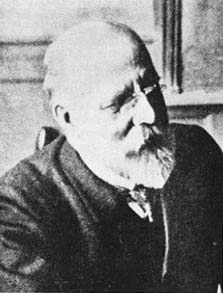
Not so, however, Charles Clermont-Ganneau. Clermont-Ganneau, who was later to distinguish himself as a scholar in Oriental studies, had arrived in Jerusalem at the age of 21, just a year before Klein’s discovery of the stone. Clermont-Ganneau was then serving as a young interpreter (dragoman) in the French consulate in Jerusalem. When he heard about the find, about October of 1869, he dispatched a trusted Arab friend, Sali
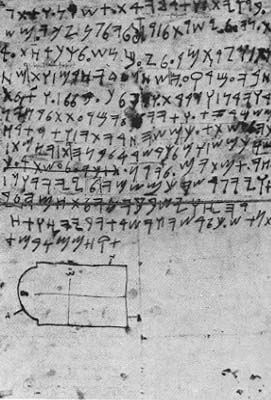
While Karavaca was waiting for his squeeze of the inscription to dry, a quarrel broke out among the local people that became so violent that Karavaca, who by this time had already received a spear-wound in the fracas, feared for his life. He tore the wet impression off the stone, jumped on his horse, and galloped away. The squeeze, in rags, tore into seven pieces.
In the meantime, the Prussian consul Petermann, frustrated by what seemed like endless, unsuccessful attempts to obtain the stone, called upon the Turkish authorities to help him. At this time, Transjordan, like most countries of the Near East, was, as I have noted, at least nominally part of the Turkish empire. However, Petermann’s request for help from the Turkish authorities was followed by months of official negotiations before it led to any results. Finally, the Turkish authorities in Palestine were ready to send soldiers to Transjordan to obtain the stone by force. The people of Dhiba
Another motive for the destruction of the stone—totally baseless—is given by Werner Keller in his error-ridden best-seller, The Bible as History. According to Keller: “The Arabs had blown it to pieces with gunpowder [also wrong]—from avarice. They hoped to do a more profitable trade with Europeans whose obsession with antiquity would make them willing to buy the individual pieces.”
After the stone was destroyed, the Germans seemed to lose interest in the monument. At least they made no efforts to obtain any of the fragments. But Clermont-Ganneau and Warren both tried to purchase as many fragments as possible. Clermont-Ganneau was the more successful. He obtained several of the large pieces and many small ones, in all 38 fragments containing a total of 613 letters out of a total of about 1,000. Warren, with the help of his Arab friends, was able to buy 18 small fragments containing 59 letters. One additional fragment was later purchased by a German scholar named Konstantin Schlottmann. The 57 pieces thus salvaged comprise approximately two-thirds of the original inscription.
More than a century has now passed since the stone was destroyed, but we still don’t know what became of the many missing fragments comprising about one-third of the original monument. The Bedouin, probably unwilling to part with them, may have buried them and in the course of time forgotten where.
Thus, the seven pieces of Karavaca’s extremely poor squeeze made for Clermont-Ganneau constitute the only copy of the complete inscription.
The 38 fragments Clermont-Ganneau acquired went, in 1873, into the large Near Eastern collection of antiquities in the Louvre, the French national museum. The Palestine Exploration Fund, into whose possession Warren’s 18 small fragments had come, generously presented them to the Louvre as well. Later Professor Schlottmann’s daughter donated to the Louvre the fragment obtained by her father.
With the seven pieces of Karavaca’s squeeze as a guide, Clermont-Ganneau was able to assemble the broken fragments and reconstruct almost the entire inscription, including the missing portions. So, in the end, this squeeze, imperfect as it was, became critical. For many years, this poor paper squeeze hung behind glass, side-by-side with the original stone in the Louvre and gave scholars an opportunity to check Clermont-Ganneau’s reconstruction.1
Even now, 118 years after its discovery, the Moabite Stone with its text of 34 lines is still the longest monumental inscription that has been discovered anywhere in Palestine, east or west of the Jordan River.
Its importance as an ancient monument can hardly be overemphasized. When translated, it turned out to be a victory monument erected in the ninth century B.C. by Mesha, king of Moab. The script is Phoenician, sometimes called paleo-Hebrew; it is the same script used by the Israelites. Also the language the Moabites used, as revealed in the inscription, is almost identical to that used by the Israelites.
The text of the inscription refers to King Mesha’s successful Moabite rebellion against—and military victory over—the Israelites. The conflict between Moab and Israel is also described in the Bible but, not surprisingly, from a different angle. The Bible presents a military campaign against King Mesha of Moab mounted by an alliance of three kings—the king of Israel, the king of Judah and the king of Edom. The Moabite Stone describes events not mentioned in the Bible and the Bible describes events not mentioned in the Moabite Stone.
Both accounts—in 2 Kings 3 and in the Moabite Stone—begin by telling the reader that King Mesha had been a vassal of the king of Israel, but had rebelled in the 054time of King Omri’s grandson. Omri was the founder of a dynasty of four kings of Israel in the ninth century B.C. that included his son Ahab and his two grandsons Ahaziah and Jehoram. Mesha’s account says nothing about the punitive military campaign of the allied Hebrew-Edomite armies against Moab following his rebellion. Instead, he describes his own conquest of Israelite territory and how he humiliated the Israelite tribe of Gad, whose territory he occupied, according to the Moabite Stone. The Bible, on the other hand, knows nothing of any Moabite victory or humiliation of Gad.
According to the Moabite Stone, Moab had been subjugated by Israel because Kemosh, the Moabite god, had been angry with Moab. After a vassalage of 40 years, according to the inscription, Mesha declared his independence and stopped paying the annual tribute which, according to 2 Kings 3:4, amounted to 100,000 lambs and the wool of 100,000 rams. The vassalage began, according to the Moabite Stone, in the reign of Omri and ended under his son. However, the expression “son” can mean “grandson” or “descendant,” as we know not only from the Bible but also from other ancient Near Eastern inscriptions. The combined reigns of Omri and of the three kings who followed him—his son Ahab and his two grandsons, Ahaziah and Jehoram—amounted to no more than 44 years—from 885 B.C., when Omri came to the throne, to 841 B.C., when Jehoram, the last king of the descendants of Omri, was killed by Jehu in a military coup that initiated Jehu’s own dynasty.2 So it is possible the vassalage lasted for 40 years. But there is a problem. According to the Biblical account of the Moabite rebellion, Jehoshaphat, king of Judah, took part in the punitive campaign the Bible describes against Moab that followed Mesha’s rebellion. The rebellion therefore must have occurred before Jehoshaphat’s death in 848 B.C.3 This was 37 years after Omri began to reign in Israel. Thus either Mesha’s statement is incorrect (Moab’s vassalage did not last 40 years), and he gave us an exaggerated figure, or the subjugation of Moab began at a time when Omri was not yet king but was still commander of the army under either King Elah or King Baasha, who preceded him on the throne of Israel (compare 1 Kings 16:16).
Since Jehoshaphat, king of Judah, took part in the campaign against Moab, the rebellion and its subsequent punishment must have taken place between 853 B.C., when Ahaziah of Israel began his reign, and 848 B.C., when Jehoshaphat of Judah died.
The two royal houses of Israel and Judah lived on friendly terms with one another during the years of the reign of King Ahab and his two sons Ahaziah and Jehoram. This friendship between the two dynasties went so far that a princess of the northern kingdom of Israel, King Ahab’s daughter Athaliah, married the Judean crown prince Jehoram, Jehoshaphat’s son (2 Kings 3:16, 18, 26). Therefore it is not surprising that King Jehoshaphat joined his northern relative in a military campaign against rebellious Moab, as he had done in an earlier war against the Syrians (1 Kings 22:1–38). Somehow the king of Edom was also persuaded to join the coalition against Moab (2 Kings 3:9).
It must have been a formidable army that set out on this campaign. From Assyrian sources, we know that Jehoram’s father, Ahab, was able to put a force of 10,000 foot soldiers and 1,000 chariots into the field in the battle of Qarqar in 853 B.C.4 Ahab’s sons presumably had this same force available to fight Moab. Assuming that Judah, a smaller and weaker state than Israel, could muster half as many men as Israel and that Edom could muster at least 2,000 soldiers for the campaign, the total strength of the combined armies could easily have amounted to 20,000 fighting men. The logistics of such problems as feeding such a force in a wilderness country obviously posed formidable difficulties.
On the recommendation of Jehoram, the alliance of Israel, Judah and Edom decided to attack Moab from the south rather than the north (2 Kings 3:8). The northern border of Moab was marked by the deep canyon of the Arnon, three miles wide and 2,300 feet deep. This mighty gorge, a Near Eastern “Grand Canyon,” formed an extremely effective natural barrier between Moab and Israel. The allied forces may have considered the crossing of this gorge in the face of brave, determined defenders too difficult, and thus decided to invade Moab from the south, although this meant having to pass through an arid, forbidding wilderness.
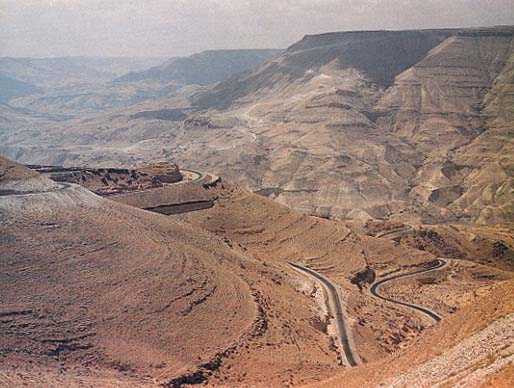
Somehow the difficulties of this passage through the wilderness were underestimated; after seven days of marching, somewhere south of the Dead Sea near the southern border of Moab, the allied armies ran out of water. Man and beast were near perishing when the prophet Elisha, who had joined the campaign, was called upon for help. Elisha, although chastising both the king of Israel and the king of Judah, nevertheless predicted that the dry valley bed would be full of water pools overnight, although neither wind would be felt nor rain be seen (verses 16–17). The next morning a flood rushed down from the Edomite mountains and filled the valley with life-saving water (verse 20).
Although the coming of this sudden stream at the predicted time was a miracle that saved the allied armies from destruction, such sudden and unexpected floods occur frequently in that area. Rains often fall during the winter months in the distant, barren mountains. Not 055retained by any vegetation or soil, the water rushes into the dry valleys, causing flash floods, which in minutes can trap any animal or person who has strayed from high ground. A few years ago a group of Belgian tourists drowned in a flash flood that suddenly filled the entrance gorge to Petra in Edom.
The Bible also says the water in this flash flood flowed red (verse 22). Certain areas of the Edomite country contain colorful reddish sandstone mountains. Rushing floodwaters often carry with them great amounts of weathered rock material that colors the water. It is not unusual to see mountain streams after heavy rains carrying reddish-brown water, which can give the impression that the waters are bloody, as, according to the Bible, the Moabite king Mesha interpreted it.
This red water led the Moabites to conclude that the allied armies had quarreled among themselves and gotten into a bloody, fratricidal battle (verses 22–23). Rushing into a precipitate attack against the combined armies of the allies, the Moabites, expecting easy victory over the Hebrew-Edomite army, were humiliatingly defeated and completely routed (verse 24).
The comparatively easy victory allowed the allies to invade Moab without encountering serious resistance. The allies conquered the Moabites’ towns and destroyed their agriculture. However, the capital city, Kir-hareseth, modern Kerak, to which the defenders had retreated, held out (verse 25). This city is built on a 2,500-foot long, narrow mountain plateau, 17 miles south of the river Arnon and 11 miles east of the Dead Sea. The city lies 0563,110 feet above the Mediterranean Sea and 4,400 feet above the Dead Sea. It is isolated from the surrounding hills, which overlook the city, by valleys more than 300 feet deep. To come to more recent times, it is of interest to know that the Christian Crusaders, recognizing the invulnerable strategic location of the site, made Kerak into one of their strongest fortresses in the Near East under King Fulco of Jerusalem in about 1140 A.D. Many of these medieval fortifications, although partly in ruins now, have survived, and leave a lasting impression on modern visitors.
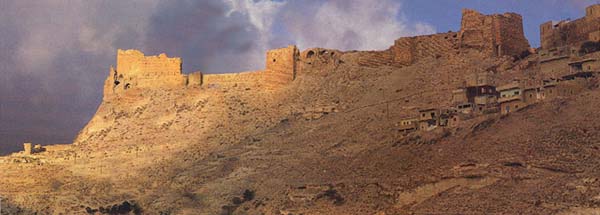
The allied Hebrew-Edomite armies hoped to take Kir-hareseth by siege, apparently assuming that outright capture through a frontal assault was too costly, or perhaps impossible. The situation inside the city under siege grew strained and demoralized; water and food were doubtless in short supply. Mesha, with a force of 700 men, decided to make an attempt to break through the line of the besiegers, choosing the Edomite sector as the probable weakest spot. The attempt failed, however, and the Moabites were thrown back (verses 25–26).
In utter desperation, Mesha then sacrificed his oldest son, the crown prince, as a burnt offering. He did so on top of the city wall in the sight of the enemy forces. It must have been a gruesome and awe-inspiring spectacle. Here was the king giving up his son as a sacrifice in order to obtain help from his god Kemosh in this hour of dire need (verses 26–27).
The Biblical record is extremely brief with regard to the results of this ghastly deed. It merely says, “There was bitter indignation against the Israelites, who then withdrew, retiring to their own country” (verse 27). We are informed by this short statement merely that the allies broke off the siege and resumed to their homelands. From other Biblical, as well as non-Biblical sources, we know that Moab remained an independent nation for the next two centuries. However, we look in vain for any explanation of what actually happened to the allied armies after witnessing the immolation of the Moabite crown prince.
What does it mean, “There was bitter indignation against the Israelites”? Were the Moabite forces so strengthened by their king’s self-abnegating sacrifice that they fought with a renewed spirit of desperation and self-sacrifice and defeated the allies, forcing them to retreat? Did the wrath of Yahweh come upon the allied armies? And if so, why? In what way did his wrath manifest itself? In the outbreak of a disease? Or fear among the soldiers? These questions have been asked by Bible readers and commentators for centuries, but no one has been able to give a satisfactory answer.5
All we know from the Biblical record is that the punitive campaign by the three allied armies against Moab, after gaining some initial success, failed to reach its ultimate aim, the return of Moab to Israelite vassalage. Moab emerged ravaged and bleeding, but with its independence preserved. Indeed, it must have soon recovered for it quickly went from the defensive to the offensive—invading Israelite lands north of the Arnon. It is at this point that we get additional information from the Moabite Stone.
Biblical Dibon, where the Moabite Stone was discovered, lies three miles north of the Arnon River. This river runs through the mighty canyon that from time immemorial had formed the northern boundary of Moab (Numbers 21:13; Deuteronomy 3:16; Joshua 13:16).
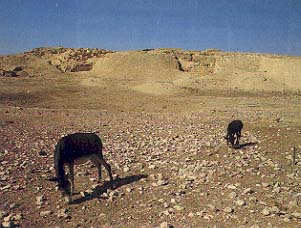
This canyon and the river running through it probably led the alliance of Israel, Judah and Edom to attack Moab from the south, even though Israelite territory lay just north of the Arnon. This canyon proved no barrier to Mesha, however, according to the Moabite Stone. Mesha crossed the canyon and captured the Israelite city of Dibon.

The fact that the stone was found at Dibon gives credence to Mesha’s claim. After his victory, Mesha erected a victory monument—the Moabite Stone—inscribing on its face a text that boasted in 34 lines of his military and political accomplishments.
In the first two lines he calls himself “the Dibonite,” a designation that is rather obscure. Since Mesha’s father had also been king of Moab, it seems unlikely that Mesha 057was a renegade Israelite from Dibon. It has been suggested that Mesha may have adopted the name Dibonite after his conquest of this important Israelite city, just as the British General B. L. Montgomery adopted the name Viscount Montgomery of Alamein when he was knighted for his victory over Rommel’s Afrika Korps at El-Alamein on the North African coast during World War II. This is certainly a reasonable possibility.
As a victory stele, the Moabite Stone is similar in character, form and purpose to the victory inscriptions found on Egyptian, Assyrian and other ancient monuments. For example, in common with them it mentions only matters of which the nation, its god and its king could be proud, and ignores unfavorable events, such as defeats, catastrophes, and military and political mistakes.
Monumental inscriptions on freestanding stones or temple walls were produced for propaganda purposes and for the glorification of the national god and the country’s ruler. Hence, it is not surprising that Mesha makes no mention of the military campaign of the kings of Israel, Judah and Edom against his country, of which the Bible gives us a detailed account.
Little happened during that war of which the Moabites could be proud. Most likely, they wanted to forget their having attacked the Hebrew-Edomite invaders at the red-colored floodwaters under the illusion that they were confronting a half-beaten army bloodied by internecine rivalries; they did not want to be reminded of their ensuing defeat, of the ravaging of their country and cities by the Hebrews, of the long siege of their capital and the unsuccessful attempt of their army to break through the enemy line, and finally of the desperate royal sacrifice. Although in the end the siege of their capital was lifted and the enemy armies forced to leave, the mention of the war would bring up so many unpleasant memories that it doubtless seemed wiser to ignore it altogether in a historical summary of Mesha’s political achievements and accomplishments.
The inscription (lines 1–7) mentions briefly Moab’s subjugation by Omri and a 40-year vassalage, which Mesha broke with the help, as he believed, of his god Kemosh, in whose honor the king built a high place at 058Qorchah. From the Biblical record we learn that in the early tenth century B.C. Solomon had built a high place for that same god Kemosh, “the abomination of Moab,” on the Mount of Olives, east of Jerusalem (1 Kings 11:7). Solomon’s Kemosh sanctuary stood there until King Josiah finally destroyed it in the late seventh century B.C. (2 Kings 23:13). The site of Qorchah, where Mesha built his Kemosh shrine, is unknown. Some have suggested it must be close to Dibon, since the victory monument recounting the building of this open-air sanctuary was found at Dibon, but this is uncertain.
Mesha’s stele also makes sport of Israel’s God, Yahweh, whom Mesha mentions in connection with his conquest of Nebo, another Israelite city east of the Jordan (lines 14–19). This occurrence of the name Yahweh, spelled just as it is in the Hebrew Bible, is the earliest reference to Yahweh in any known inscription or text. Mount Nebo, located about 12 miles east of the mouth of the Jordan River, is well known from the narrative about Moses. It was there that Moses before his death viewed the Promised Land (Deuteronomy 34). In later times, a town was built on this mountain. Recently, this town has been excavated under the direction of Sylvester J. Saller and Bellarmino Bagatti.6 But no remains of an Israelite town on Mt. Nebo have yet been found.
Yet it seems that either a temple or an open-air sanctuary dedicated to Yahweh must have existed in the town of Nebo at the time of Mesha’s reign, since he claims to have taken from there cult vessels of Yahweh, which he placed before Kemosh (lines 17, 18). We know 059from the Biblical records as well as from archaeological evidence that Yahweh shrines existed in various parts of the country during the period of the Hebrew kings until the pious kings Hezekiah and Josiah destroyed them. Well-preserved ruins of one such Hebrew Yahweh temple have recently been excavated at Arad in southern Judea,7 and an ancient pilgrim’s shrine dedicated to Yahweh was discovered at Kuntillet Ajrud in the southern Negev.8
Israelite Nebo must have been a town of considerable size, because Mesha claims that in its conquest he captured “7,000 men, [boys], women, [girl]s and maidservants” (lines 16–17). These he “devoted” to the god Ashtar-Kemosh. Why did he “devote” the people of Nebo to the Moabite god? Probably because they came from a town where Yahweh worship had been prominent; in order to humiliate the Israelite God and honor his own deity, Mesha meted out harsher treatment to the Yahweh worshippers than to the Israelites of other captured cities.
It is not clear what Mesha means when he says that he “devoted” these people to his god Kemosh. Mesha may have made them temple slaves, to spend their lives in the service of the Moabite god. It is also possible that Mesha, who had slaughtered his own son as a burnt offering to Kemosh (2 Kings 3:27), slew all these people as sacrifices to Ashtar-Kemosh.
Another puzzle: Precisely who was the deity Ashtar-Kemosh? Was he a god with a dual name or were two gods meant? From the Bible and other ancient texts we are acquainted with a female deity Ashtaroth, or Astarte, but Ashtar in Ashtar-Kemosh is a masculine name and 061indicates that a male god was involved. In the north Syrian city of Ugarit and in southern Arabia a male god Ashtar was worshipped.9 Probably the national Moabite god Kemosh was identified with the god Ashtar and was known at least in one place in Moab under the name Ashtar-Kemosh.
Mesha’s account of events confirms the fact that the area north of the Arnon River was occupied by Israelites before Mesha’s rebellion; Mesha also confirms that these Israelites belonged to the tribe of Gad (Deuteronomy 3:12), for he says in lines 10–12 of the Moabite Stone, “Now the men of Gad had dwelt in the land of Ataroth from of old, … but I fought against the city, took it, and smote all the people of the city as an intoxication for Kemosh and for Moab.”
Mesha claims that altogether he added to his territory 100 [Israelite] towns (line 29), and that he rebuilt many towns and villages that had been destroyed, and constructed new roads and cisterns—using as laborers for these public works many “prisoners of Israel” (lines 25–26).
On the map in the sidebar, some cities mentioned by name in the Moabite Stone are shown as far as they can reasonably be identified. However, it is clear that Mesha nearly doubled the size of his country by his conquest. He apparently went almost as far as Heshbon, the former Amorite capital of Sihon, which at this time also belonged to the Israelites. Mesha mentions Medeba among the conquered cities, but not Heshbon, which was located only five and a half miles north of Medeba Apparently Mesha’s military conquest halted just north of Medeba and south of Heshbon.
This historical reconstruction has assumed that the military events described in the Moabite Stone followed the Hebrew-Edomite campaign to re-suppress Moab after Mesha’s rebellion against Israel. Although the Bible does report that the allied siege of the Moabite capital was unsuccessful and that thereafter Moab remained an independent country, it does not report Mesha’s campaign against Israel. According to some scholars, this Moabite campaign against Israel recounted in the Moabite Stone preceded the Hebrew-Edomite campaign against Moab. According to this theory, the Moabite campaign against Israel was part of the Moabite rebellion.
Albert T. Olmstead, for example, believes that the circuitous route taken by the allies in their invasion tactics proves that the events described on the Moabite Stone precede the allies’ invasion, for by attacking Moab from the south they avoided the time-consuming task of first having to conquer the newly fortified cities of Mesha’s recently acquired Israelite territory.10
On the other hand, those, among them this writer, who believe that the allied invasion of Moab precedes the events described by Mesha on his victory monument, point out that it must have taken Mesha years to carry out the fortification works he describes, while the Biblical record gives the impression that the allied military campaign quickly followed Mesha’s rebellion and cessation of the annual payment of tribute. Furthermore, Mesha’s reference to rebuilding destroyed cities (line 27) seems to point to the recent Hebrew-Edomite military campaign against his land, during which they devastated the towns of Moab so that only its capital Kir-hareseth was left to Mesha (2 Kings 3:25).11
However, neither side can prove its case with certainty. There is still much we do not know. Many historical events recorded in the Moabite Stone cannot be corroborated. And even after 117 years a number of phrases in the inscription are not fully understood from a linguistic standpoint. So we must continue to live with a degree of uncertainty.
F. A. Klein was an Anglican minister, born in Alsace, who came to the Holy Land as a medical missionary in the mid-1800s. Although he lived in Jerusalem, he traveled widely on both sides of the Jordan, seeking to relieve pain and win converts. As a result of his work in Palestine, he spoke Arabic fluently and had many friends among the Arabs. Indeed, he was the only Westerner who could travel without danger in certain areas east of the Jordan, where the Bedouin were a law unto themselves. The Turkish government, although officially in control of the countryside, […]
You have already read your free article for this month. Please join the BAS Library or become an All Access member of BAS to gain full access to this article and so much more.
Already a library member? Log in here.
Institution user? Log in with your IP address or Username
Endnotes
For a fully documented history of the discovery of the Moabite Stone, see Siegfried H. Horn, “The Discovery of the Moabite Stone,” in Carol L. Meyers and M. O’Connor, eds., The Word of the Lord Shall Go Forth: Essays in Honor of David Noel Freedman (Winona Lake, Ind.: Eisenbrauns, 1983), pp. 497–505.
All regnal dates for the kings of Israel and Judah are presented here according to Edwin R. Thiele’s The Mysterious Numbers of the Hebrew Kings, 3rd ed. (Grand Rapids, Mich.: Eerdmans, 1983). Some scholars using alternate chronological schemes have come to slightly different dates than those of Thiele’s system. For example, John Bright, using William F. Albright’s chronology (Bulletin of American Schools for Oriental Research 100 [December 1945], pp. 16–22), in his A History of Israel, 2nd ed. (Philadelphia, 1972), unnumbered pages after p. 474, dates the accession of Ahaziah of Israel to 850 B.C. instead of 853 B.C. and the date of Jehoshaphat’s death to 849 B.C. instead of 848 B.C. as presented here.
Some commentators, however, consider Jehoshaphat’s name a later addition and believe that the king of Judah who participated in the Moabite campaign was Jehoshaphat’s son Jehoram, a namesake, and also brother-in-law, of the king of Israel. See, for example, The Jerusalem Bible (New York, 1966), p. 457, note c.
For a translation of the Assyrian record of the battle of Qarqar in which King Ahab of Israel participated, see James B. Pritchard, ed., Ancient Near Eastern Texts Relating to the Old Testament (Princeton, New Jersey, 1950), pp. 178–279.
See James A. Montgomery and Henry S. Gehman’s summary of the scholarly discussion on this subject in their Commentary on the Books of Kings (New York, 1951), pp. 363–364.
Yohanan Aharoni, “Arad,” in Michael Avi-Yonah, ed., Encyclopedia of Archaeological Excavations in the Holy Land, I (Jerusalem, 1975), pp. 85–87.
Ze’ev Meshel, “Did Yahweh Have a Consort?” BAR 05:02; Meshel and Meyers, “The Name of God in the Wilderness of Zin,” Biblical Archaeologist 39 (1976), pp. 6–10.
John Gray, “The Desert God ‘At
Albert T. Olmstead, History of Palestine and Syria (New York, 1931), pp. 389–393. A similar view is held by Anton Jirku, Altorientalischer Kommentar zum Alten Testament (Leipzig, 1923), p. 163.
